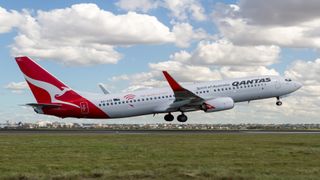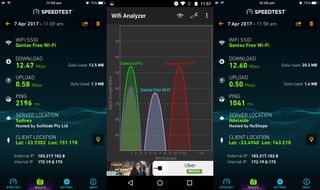We tested Qantas’ free inflight Wi-Fi (and the results were surprisingly good)
Stream Netflix, Stan and Foxtel for free at 30,000ft

It was mid-February when Qantas announced not only its partnership with streaming services Foxtel, Netflix and Spotify, but also its plans for providing high-speed Wi-Fi to its domestic passengers.
This was soon followed by a test flight with 140 of the national airline’s employees testing out the system and it came out with flying colours, reaching speeds of up to 12Mbps.
But after months of testing and an initial hiccup, which saw Qantas postpone the launch of it inflight Wi-Fi, the Flying Kangaroo is now well and truly ready to let domestic customers enjoy a world of entertainment.
Qantas today beat Virgin Australia by switching on Wi-Fi aboard a Boeing 737-800 that was chartered to fly Qantas chief Alan Joyce and the media on the inaugural public of the service.
“Inflight Wi-Fi has been on our wish list for quite a while, but the sheer size of Australia meant it was hard to offer a service that was fast and reliable,” said Joyce.
High-flying high speed internet

We were invited along for the ride to put the system through its paces and, like the aforementioned test flight, it was a success.
Initially, there was disappointment regarding connectivity, with the Wi-Fi constantly dropping out, but that was during taxiing, take off and the climb to cruising height. Once the seatbelt signs were switched off, they connection stabilised and it was smooth sailing from then on.
Are you a pro? Subscribe to our newsletter
Sign up to the TechRadar Pro newsletter to get all the top news, opinion, features and guidance your business needs to succeed!
We streamed some videos on both Netflix and Stan (the latter partnered with Qantas in March) and, despite being warned that there was a latency of about 20 to 30 seconds, we found no buffering issues whatsoever.
We even managed to get some work done – catching up with emails and our colleagues on the ground.
Speed tests revealed that we consistently achieved over 12Mbps download speeds, which is way better than the Aussie average of 9.4Mbps.
How the Wi-Fi system works
Qantas’ inflight Wi-Fi uses the NBN Co’s two Sky Muster satellites stationed 36,000km above the Earth, orbiting at speeds of 28,000kph. Each satellite has 101 spot beams that pretty much cover the entirety of Australia.
Whenever someone accesses a web page, a signal is sent and received between the ground and the satellites. Though the satellites will prioritise internet use on the ground, there is sufficient bandwidth to cater to the high-fliers as well.
The Flying Kangaroo has partnered with ViaSat, a company that provides high-speed satellite broadband and secure networking systems, to provide connectivity between aircraft, satellites and the ground.
The Wi-Fi system’s hardware, installed by engineers in Brisbane, consists of a satellite antenna installed atop the aircraft and numerous wireless access points that deliver similar speeds throughout the plane. So no matter where you’re sitting, Qantas has made sure you can stream shows and movies or get some work done just as quickly as the next person.
And everything else you need to know

If you’re curious about the not-so-technical Wi-Fi info offered by Qantas, let’s start by telling you it’s absolutely free.
And as for the devices you can use – your smartphone, tablet or laptop (or all three) are just fine.
But, at present, it's just the one aircraft that’s internet-enabled and still in beta testing. So if you’re taking a Qantas flight between Melbourne, Sydney and Brisbane, look out for a plane with the tail number VH-XZB. If that's the flight you're on, you could enjoy your favourite shows and movies, watch sports, stream music or just stay in touch with folk on the ground while you cruise 30,000ft above sea level.
Qantas hopes to complete testing by the middle of this year, with a roll-out that will see 80 aircraft in its domestic fleet (Boeing 737s and Airbus A330s) internet-enabled by the end of 2018.
- If you aren’t travelling anywhere, but still want great Wi-Fi at home, here’s how you can achieve that.

Sharmishta is TechRadar's APAC Managing Editor and loves all things photography, something she discovered while chasing monkeys in the wilds of India (she studied to be a primatologist but has since left monkey business behind). While she's happiest with a camera in her hand, she's also an avid reader and has become a passionate proponent of ereaders, having appeared on Singaporean radio to talk about the convenience of these underrated devices. When she's not testing camera kits or the latest in e-paper tablets, she's discovering the joys and foibles of smart home gizmos. She's also the Australian Managing Editor of Digital Camera World and, if that wasn't enough, she contributes to T3 and Tom's Guide, while also working on two of Future's photography print magazines Down Under.
